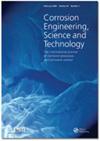Understanding imidazole derivatives effect as a corrosion inhibitor for brass in nitric acid: a combined experimental and theoretical assessments
IF 1.5
4区 材料科学
Q4 MATERIALS SCIENCE, MULTIDISCIPLINARY
Corrosion Engineering, Science and Technology
Pub Date : 2022-09-08
DOI:10.1080/1478422X.2022.2119706
引用次数: 4
Abstract
ABSTRACT This paper presents a new study on imidazole derivatives namely 1H-imidazole (IM), N-methylimidazole (MIM) and 1H-benzimidazole (BIM) as a corrosion inhibitor for brass in nitric acid medium. Electrochemical results demonstrate that the inhibition increases with a high concentration of imidazole derivatives; the inhibitory efficiency reaches a maximum of 94% at 10–2 mol L−1 for BIM. SEM morphology and EDS analysis show that these derivatives are adsorbed onto the brass interface, the brass sample is effectively protected and the surface becomes relatively flat, which is more significant in the presence of 1H-benzimidazole. FTIR results confirm the retention of BIM on the interface of Cu-Zn alloys. In addition, quantum chemistry calculation manifests that the three derivatives can reveal high anticorrosion properties. Molecular dynamics simulation data manifest that the three imidazole derivatives can be adsorbed at the brass surface in a paralleled way, and have large binding energy. Highlights A new action of imidazole derivatives to mitigate brass corrosion was explored in HNO3. BIM showed inhibitory efficiency more than 94% in HNO3 solution. The inhibition mechanism is studied using SEM/EDS surface analysis and FTIR analysis. The calculated adsorption energies are ranked in the following order: BIM > MIM > IM. Theoretical and experimental results lead to used imidazole derivatives as potential corrosion inhibition for brass in solution. GRAPHICAL ABSTRACT了解咪唑衍生物作为黄铜在硝酸中的缓蚀剂的作用:实验和理论相结合的评估
摘要本文对咪唑衍生物1H-咪唑(IM)、N-甲基咪唑(MIM)和1H-苯并咪唑(BIM)作为黄铜在硝酸介质中的缓蚀剂进行了新的研究。电化学结果表明,咪唑衍生物的浓度越高,抑制作用越强;在10-2时,抑制效率最高可达94% 摩尔 BIM为L−1。SEM形貌和EDS分析表明,这些衍生物被吸附在黄铜界面上,黄铜样品得到了有效的保护,表面变得相对平坦,这在1H-苯并咪唑存在下更为显著。FTIR结果证实了BIM在Cu-Zn合金界面上的保留。此外,量子化学计算表明,这三种衍生物具有较高的防腐性能。分子动力学模拟数据表明,三种咪唑衍生物可以平行吸附在黄铜表面,并具有较大的结合能。亮点研究了咪唑衍生物在HNO3中缓蚀黄铜的新作用。BIM在HNO3溶液中的抑制率超过94%。采用扫描电镜/能谱仪(SEM/EDS)表面分析和傅立叶变换红外光谱(FTIR)分析对其缓蚀机理进行了研究。计算的吸附能按以下顺序排列:BIM>MIM>IM。理论和实验结果表明,咪唑衍生物对黄铜在溶液中具有潜在的缓蚀作用。图形摘要
本文章由计算机程序翻译,如有差异,请以英文原文为准。
求助全文
约1分钟内获得全文
求助全文
来源期刊

Corrosion Engineering, Science and Technology
工程技术-材料科学:综合
CiteScore
3.20
自引率
5.60%
发文量
58
审稿时长
3.4 months
期刊介绍:
Corrosion Engineering, Science and Technology provides broad international coverage of research and practice in corrosion processes and corrosion control. Peer-reviewed contributions address all aspects of corrosion engineering and corrosion science; there is strong emphasis on effective design and materials selection to combat corrosion and the journal carries failure case studies to further knowledge in these areas.
 求助内容:
求助内容: 应助结果提醒方式:
应助结果提醒方式:


